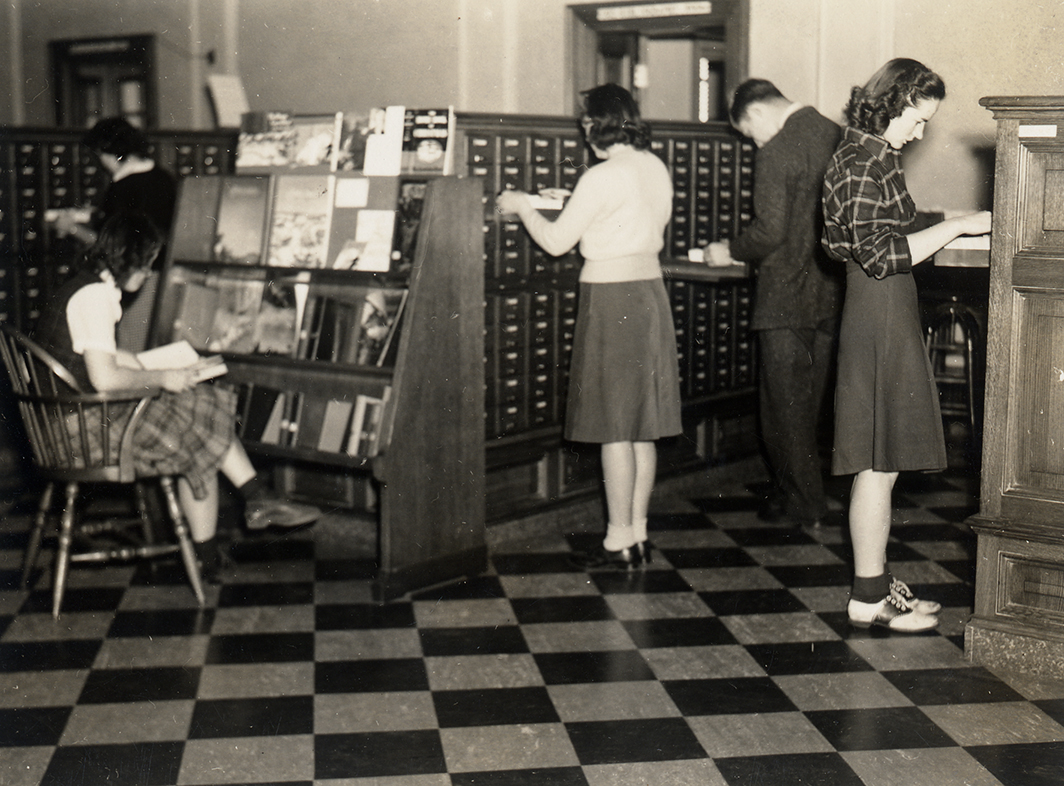
This is a guest post by Amy Allen written in celebration of National Library Week and the 2016 theme, Libraries Transform. Allen is an University of Arkansas alumna and the University Archivist in Special Collections at the University of Arkansas Libraries. She works everyday to collect and preserve the history of the U of A. Allen published University of Arkansas in Arcadia Publishing’s Campus History Series last October. The book is available online.
The University Libraries have transformed from a modest beginning of only 137 books in 1872 by making advances in spaces, services and technology. When Old Main opened in 1876, space was dedicated for library books, although the library was only open for use 1.5 hours each day. By 1910, the volumes in the library had increased to over 10,000, and the space was open between 8:30 and 5:00, run almost entirely by students.
Old Main Library, 1928, Special Collections Picture Collection 1528a
When John C. Futrall became the U of A president in 1914, library conditions took a leap forward. Futrall hired the University’s first professional librarian, Miss Julia Vaulx, who would remain the librarian for more than 20 years. During her time as librarian, the library collections and use steadily increased. In 1922, the first evening hours were available from 7:30 to 9:30 – for men only!
By the 1930s, the library housed over 100,000 volumes, and the space in Old Main became inadequate. With financial assistance from the Public Works Administration, the University’s first library building was built just west of Old Main. The building opened in the fall of 1935 and was named J. Vol Walker Memorial Library, in honor of James Volney Walker, an Arkansas lawyer and alumnus who died not long before the library was completed.
A sunbathed Vol Walker Library Reading Room, Special Collections Picture Collection 1388a
The new library was a tremendous improvement. It had three reading rooms, which allowed seating for up to 500 patrons, and seating for an additional 100 patrons in other spaces. Vol Walker Library also contained a suite of offices for the University’s president, a seminar room, 50 cubicles and space for 250,000 volumes. During this era, Librarians began to instruct freshman on how to use the library. By 1948, just 13 years after opening, the library holdings had already reached 227,000 volumes.
Students using the card catalog in Vol Walker Library, 1942, Special Collections Picture Collection 1405
In 1964 the library added its 500,000th volume, a book written by Frank Lloyd Wright, and resources once again outgrew the available space. A new library was built in 1968 just west of Vol Walker. This building, which is still the main research library on campus, was named after U of A President David Mullins in 1975.
A very clean Mullins Library, ca. 1968, Special Collections Picture Collection 4187
Mullins Library ushered in a new era. The modern library replaced formal reading rooms with study space placed throughout the building for 1800 people and contained dedicated space for audiovisual materials, microfilm, and maps. The biggest change was that for the first time the stacks were “open,” and students could browse through the stacks of materials to select items for themselves. Also, a Special Collections department was established to collect rare books and manuscript material to document the history of the University and of the state of Arkansas. All of the historical photographs seen here were drawn from Special Collections.
An audiovisual listening room in Mullins Library, ca. 1968, Special Collections Picture Collection 4193
By the 1980s, library holdings no longer included just physical objects, but moved into the digital realm with a Computer Assisted Research Service offered by the Reference Department, and the first digital databases available on CD-ROM. The 1990s ushered in online journal subscriptions. In 1993, the Mullins Library unveiled the first online catalog. Now, students could search the thousands of catalog records from a computer terminal rather than by drawers of physical catalog cards. In 1997, the east side addition was added to Mullins Library, creating an additional 75,000 square feet of space.
The University Libraries continue to grow and expand into the 21st century. In 2010, much of the public spaces were reconfigured to add more group study space, more computers and expanded wireless capabilities. The 2013 academic year saw the addition of the two millionth volume, a rare 1605 firsthand account of Hernando de Soto’s three-year exploration that culminated in Arkansas.
Today Mullins Library is the intellectual hub of campus and the go-to place for research and discovery with more than 2 million visits last year.
Administrators, librarians, and staff continue to transform the Libraries to serve the needs of the 21st century campus. Even if you have been in the library, don’t think you have seen everything it has to offer. New resources are continuously being added to use in the Mullins Library, The Robert A. and Vivian Young Law Library, Fine Arts Library, Chemistry and Biochemistry Library, and Physics Library, or anywhere you have internet access through the libraries website. Check out what is new and how your campus libraries will transform next.







what a nice series of images showing the transformation of building, people and study environments.